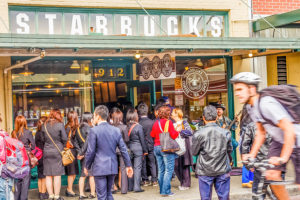What’s the magic that drives retail growth?
I hope we can agree, more often than not, the product is the marketing these days. To be successful in retail (or packaged product for that matter), the core concept and how it’s presented has way more to do with outcomes than isolated application of an external marketing tool or social savvy communications strategy.
In retail especially, we routinely see a decided lack of real, strategic emphasis on mission and experience in helping facilitate engagement. Yet, it is often retail experience and how it is managed that has more to do with sustainable business growth than any pricing strategy or transactional incentive.
In some respects, retail appears to be a business more fully anchored to balance sheet metrics than others. After all, we’re often constantly counting things like traffic, transactions, same-day store sales result, basket sizes, average ring, trip frequency – all in the name of monitoring and enabling growth. And in many cases fueled by a belief that if we’re lacking in transactions or traffic, the solution is some amalgam of incentives and marketing wizardry (geo-targeted offers) to drive the sheep into the barn.
As a result, strategy often reflexively reverts to discussions of loyalty programs, short-term incentives, promotions and digital coupons – lures we believe will tempt trial or get feet moving through the door, because we’re just one incentive away from pushing people to say yes.
The irony of that thinking is belief that wallet-based decisions lie at the front door of attraction and thus success.
What if this simply weren’t true?
The world is changing: People value unique experiences over cheap ones. They care more about quality than ever. They want to know more about what goes on behind the curtain. They value quality human interactions over convenience and speed. Belief, behaviors and mission really matter. Artisanal is better than mass – humanization over mechanization. How consumers are treated has more to do with return visits than depth of merchandise mix or service efficiency.
So much energy is devoted to discussing the finer points of pricing, incentives and consistency, when we should be talking about experience, human interactions and how to cultivate perceptions of quality and care.
Starbucks started with experience as the mission
The coffee culture giant was founded on curating a unique experience rather than manipulating price incentives, coupons and discount days. Everything about the Starbucks concept fell from an overarching mission to “bring the world a better cup of coffee.”
A wisp of European ambiance. The rich sensory odor of dark coffee roasts. The unique drink nomenclature and vocabulary built around customization. The focus on quality execution. Cultivating the ‘Third Place” social space. The training and attitude of baristas. The history and lore around beans, their origins and tasting notes. In its earliest days, the vast and measurable improvement Starbucks brought to the coffee drinking experience from what existed before it – just disruptive!
Environment, experience and associative quality cues. Relevant visual assets. Higher quality food attributes and packaging. All of this designed to create a brief immersive experience for guests who get a flavor of European coffee adventure on the way to work.
This is a testament to one thing: recognition that every person coming in the door shares one common trait. They are all human beings. We are emotional creatures who make decisions based on how we feel about the brand when we are in the presence of it. The quality product by itself becomes the affirmation of the good decision and not the cause of it.
Running a retail chain successfully, no matter the category, is an opportunity to cultivate experience, to step past the limitations of transactional thinking and look at how the human being in front of you can be made to feel.
Some strategic questions to address:
- How can we deliver the unexpected, the ‘above and beyond the call’ moment that delights and surprises?
- What investments have we made to assure customer-facing staff has embraced the retail business mission (assuming your mission has a truer, more meaningful purpose than just separating guests from their wallets)?
- What forms of hospitality training have been installed to refine and optimize the in-store experience and interaction?
- What have we done with store design and visual, sensory cues to cultivate the right emotional triggers?
- How do we show customers that we truly care about them? Moreover, what practices, products and process help facilitate nurturing and feeding the human side of the relationship?
- What’s the ‘after sale’ program designed to facilitate ongoing communication and secure honest feedback?
- What experiences do we offer past the product that are not solely self-serving and align with the lifestyle interests and aspirations of those we wish to serve?
- How do we build and encourage community and sharing among our greatest fans and followers?
- How are we giving experience the priority it deserves in our strategic planning and operations model?
It should be noted the only way to build experience strategies with a sense of real confidence is if it’s based on deep dive insight research about the people we envision as heavy users and early adopters. What matters to them? What do they care about? How do they spend their day? What are their passions and lifestyle concerns? This intimate understanding helps inform experience that’s relevant and valued.
If we can get experience to the top of the plan we have an opportunity to humanize the marketing approach and help customers ‘feel the love.’ Yes, emotion sits at the center of decisions. Is this addressed in how you go to market?
Bob Wheatley is the CEO of Chicago-based Emergent Healthy Living. Emergent provides integrated brand strategy, communications and insight solutions to national food, beverage, home and lifestyle companies. Emergent’s unique and proprietary transformation and growth focus helps organizations navigate, engage and leverage consumers’ desire for higher quality, healthier product or service experiences that mirror their desire for higher quality lifestyles. For more information, contact [email protected] and follow on Twitter @BobWheatley.


